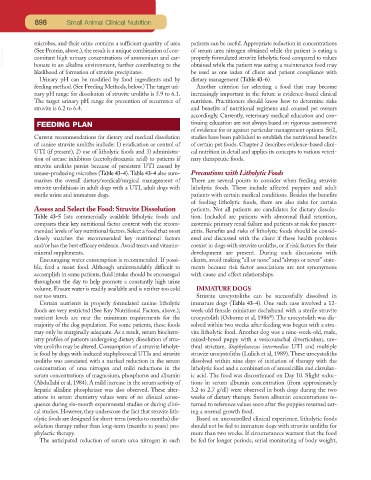Page 867 - Small Animal Clinical Nutrition 5th Edition
P. 867
898 Small Animal Clinical Nutrition
microbes, and their urine contains a sufficient quantity of urea patients can be useful. Appropriate reduction in concentrations
VetBooks.ir (See Protein, above.), the result is a unique combination of con- of serum urea nitrogen obtained while the patient is eating a
properly formulated struvite litholytic food compared to values
comitant high urinary concentrations of ammonium and car-
bonate in an alkaline environment, further contributing to the
obtained while the patient was eating a maintenance food may
likelihood of formation of struvite precipitates. be used as one index of client and patient compliance with
Urinary pH can be modified by food ingredients and by dietary management (Table 43-6).
feeding method. (See Feeding Methods, below.) The target uri- Another criterion for selecting a food that may become
nary pH range for dissolution of struvite uroliths is 5.9 to 6.1. increasingly important in the future is evidence-based clinical
The target urinary pH range for prevention of recurrence of nutrition. Practitioners should know how to determine risks
struvite is 6.2 to 6.4. and benefits of nutritional regimens and counsel pet owners
accordingly. Currently, veterinary medical education and con-
FEEDING PLAN tinuing education are not always based on rigorous assessment
of evidence for or against particular management options. Still,
Current recommendations for dietary and medical dissolution studies have been published to establish the nutritional benefits
of canine struvite uroliths include: 1) eradication or control of of certain pet foods. Chapter 2 describes evidence-based clini-
UTI (if present), 2) use of litholytic foods and 3) administra- cal nutrition in detail and applies its concepts to various veteri-
tion of urease inhibitors (acetohydroxamic acid) to patients if nary therapeutic foods.
struvite uroliths persist because of persistent UTI caused by
urease-producing microbes (Table 43-4). Table 43-4 also sum- Precautions with Litholytic Foods
marizes the overall dietary/medical/surgical management of There are several points to consider when feeding struvite
struvite urolithiasis in adult dogs with a UTI, adult dogs with litholytic foods. These include affected puppies and adult
sterile urine and immature dogs. patients with certain medical conditions. Besides the benefits
of feeding litholytic foods, there are also risks for certain
Assess and Select the Food: Struvite Dissolution patients. Not all patients are candidates for dietary dissolu-
Table 43-5 lists commercially available litholytic foods and tion. Included are patients with abnormal fluid retention,
compares their key nutritional factor content with the recom- azotemic primary renal failure and patients at risk for pancre-
mended levels of key nutritional factors. Select a food that most atitis. Benefits and risks of litholytic foods should be consid-
closely matches the recommended key nutritional factors ered and discussed with the client if these health problems
and/or has the best efficacy evidence. Avoid treats and vitamin- coexist in dogs with struvite uroliths, or if risk factors for their
mineral supplements. development are present. During such discussions with
Encouraging water consumption is recommended. If possi- clients, avoid making “all or none” and “always or never” state-
ble, feed a moist food. Although understandably difficult to ments because risk factor associations are not synonymous
accomplish in some patients, fluid intake should be encouraged with cause and effect relationships.
throughout the day to help promote a constantly high urine
volume. Ensure water is readily available and is neither too cold IMMATURE DOGS
nor too warm. Struvite urocystoliths can be successfully dissolved in
Certain nutrients in properly formulated canine litholytic immature dogs (Table 43-4). One such case involved a 12-
foods are very restricted (See Key Nutritional Factors, above.); week-old female miniature dachshund with a sterile struvite
a
nutrient levels are near the minimum requirements for the urocystolith (Osborne et al, 1986 ). The urocystolith was dis-
majority of the dog population. For some patients, these foods solved within two weeks after feeding was begun with a stru-
may only be marginally adequate. As a result, serum biochem- vite litholytic food. Another dog was a nine-week-old, male,
istry profiles of patients undergoing dietary dissolution of stru- mixed-breed puppy with a vesicourachal diverticulum, ure-
vite uroliths may be altered. Consumption of a struvite litholyt- thral stricture, Staphylococcus intermedius UTI and multiple
ic food by dogs with induced staphylococcal UTIs and struvite struvite urocystoliths (Lulich et al, 1989). These urocystoliths
uroliths was associated with a marked reduction in the serum dissolved within nine days of initiation of therapy with the
concentration of urea nitrogen and mild reductions in the litholytic food and a combination of amoxicillin and clavulan-
serum concentrations of magnesium, phosphorus and albumin ic acid. The food was discontinued on Day 10. Slight reduc-
(Abdullahi et al, 1984). A mild increase in the serum activity of tions in serum albumin concentration (from approximately
hepatic alkaline phosphatase was also observed. These alter- 3.2 to 2.7 g/dl) were observed in both dogs during the two
ations in serum chemistry values were of no clinical conse- weeks of dietary therapy. Serum albumin concentrations re-
quence during six-month experimental studies or during clini- turned to reference values soon after the puppies resumed eat-
cal studies. However, they underscore the fact that struvite lith- ing a normal growth food.
olytic foods are designed for short-term (weeks to months) dis- Based on uncontrolled clinical experience, litholytic foods
solution therapy rather than long-term (months to years) pro- should not be fed to immature dogs with struvite uroliths for
phylactic therapy. more than two weeks. If circumstances warrant that the food
The anticipated reduction of serum urea nitrogen in such be fed for longer periods, serial monitoring of body weight,

